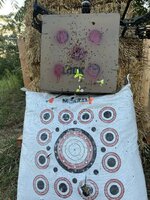mtn_man
FNG
- Joined
- Nov 12, 2022
- Messages
- 40
Wanting to get some perspective from those of you who stalk elk. I'm going out on my first archery stalk for late season elk in WA state. I've taken time off the 9-5 routine since early May to learn compound archery (needed a break anyway), so I've been working my ass off shooting daily, working on my bow, and building / testing arrows. I've hit every goal that I've set out for and then some, but I have one final thing to nail down.
For elk stalking (not from a stand or blind), I'm conflicted for what I want to use in terms of DW and arrows. I'd like to be in the 285-295FPS range regardless and have a higher FOC, 31" DL currently shooting 31" arrows with a 33" Phase 4 at 66#. With regards to FOC, I'm going for at least 16%, ideally 17-18% minimum. I've done extensive testing ever since I started building arrows this past May and have observed penetration anomalies with all of my lower FOC arrow builds exacerbated by cross winds.
These are the arrows that I'm debating:
450-460gn RIP XVs (300 spine):
Pros:
- VERY tight pin gap
- >20% FOC with incredible 50y penetration into wild hogs
- Exceptionally accurate with IW BHs and Magnus Stingers / Black Hornets
- Over 300FPS at 66# (I'd probably run them at ~63# ~295FPS)
Cons:
- Shafts are very fragile (they tend to split down the long axis)
- These fragile shafts make me nervous for field use
- On the light side for elk?
475gn RIP TKOs
Pros:
- They've very accurate, shafts are very durable
- 290FPS with an ideal elevation trajectory for my max effective range
- No signs of being under spined at 66# (tight at groups long range regardless of DW)
Cons:
- 14.2% FOC, penetration is hit or miss in the wind beyond 40y (deal breaker)
510-520gn RIP TKOs
Pros:
- Penetration is comparable to my RIP XVs (night and day difference compared to the 475gn)
- 16.8-17% FOC depending on fletch / vinyl
Cons:
- 275FPS, limits my max range for an ethical shot (the psychology of shooting these beyond 40y bugs me)
- Clearly under spined at 66#, so I'd need to build a different arrow in the 510-520gn range (I'm confident in being able to build a comparable arrow with a 250 spine)
I also have some 5mm Easton Axis arrows built out in 300 spine, but they're under spined over 64# regardless of the weight up front.
So I'm considering:
1. Taking my chances with the lighter RIP XV arrows
2. Drawing 70# to shoot the heavier arrows at the velocity that I'm looking for. I can draw 70# on my neighbor's PSE, but judging the pace at which I've worked up to 66# it'll probably take me 3-4 weeks before I'm conditioned to shoot at 70# all day (if that makes sense)
3. Open to suggestions
Thanks!
For elk stalking (not from a stand or blind), I'm conflicted for what I want to use in terms of DW and arrows. I'd like to be in the 285-295FPS range regardless and have a higher FOC, 31" DL currently shooting 31" arrows with a 33" Phase 4 at 66#. With regards to FOC, I'm going for at least 16%, ideally 17-18% minimum. I've done extensive testing ever since I started building arrows this past May and have observed penetration anomalies with all of my lower FOC arrow builds exacerbated by cross winds.
These are the arrows that I'm debating:
450-460gn RIP XVs (300 spine):
Pros:
- VERY tight pin gap
- >20% FOC with incredible 50y penetration into wild hogs
- Exceptionally accurate with IW BHs and Magnus Stingers / Black Hornets
- Over 300FPS at 66# (I'd probably run them at ~63# ~295FPS)
Cons:
- Shafts are very fragile (they tend to split down the long axis)
- These fragile shafts make me nervous for field use
- On the light side for elk?
475gn RIP TKOs
Pros:
- They've very accurate, shafts are very durable
- 290FPS with an ideal elevation trajectory for my max effective range
- No signs of being under spined at 66# (tight at groups long range regardless of DW)
Cons:
- 14.2% FOC, penetration is hit or miss in the wind beyond 40y (deal breaker)
510-520gn RIP TKOs
Pros:
- Penetration is comparable to my RIP XVs (night and day difference compared to the 475gn)
- 16.8-17% FOC depending on fletch / vinyl
Cons:
- 275FPS, limits my max range for an ethical shot (the psychology of shooting these beyond 40y bugs me)
- Clearly under spined at 66#, so I'd need to build a different arrow in the 510-520gn range (I'm confident in being able to build a comparable arrow with a 250 spine)
I also have some 5mm Easton Axis arrows built out in 300 spine, but they're under spined over 64# regardless of the weight up front.
So I'm considering:
1. Taking my chances with the lighter RIP XV arrows
2. Drawing 70# to shoot the heavier arrows at the velocity that I'm looking for. I can draw 70# on my neighbor's PSE, but judging the pace at which I've worked up to 66# it'll probably take me 3-4 weeks before I'm conditioned to shoot at 70# all day (if that makes sense)
3. Open to suggestions
Thanks!

